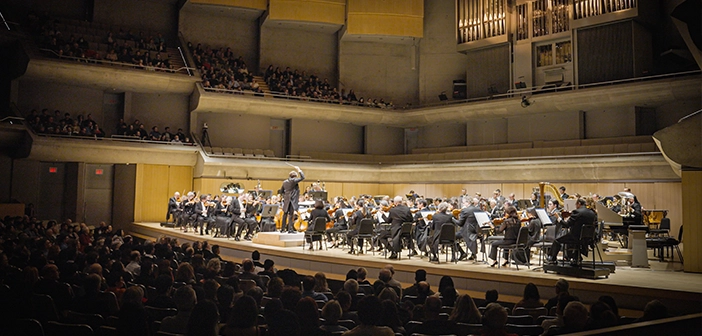There was no soloist – superstar or otherwise – at Roy Thomson Hall this sunny afternoon in early February, but the greatly augmented Toronto Symphony Orchestra gave a near-capacity audience a stunning display of orchestral fireworks, especially in two of Respighi’s Roman tone poems.
The concert was devoted to Italian music, and began with some ballet music from Verdi’s opera Macbeth. While it was well-played, it mainly served as a warm-up for what was to come. The medium-sized Verdi orchestra was dramatically expanded to include 9 percussionists, timpani, piano, organ, a mandolin, and extra trumpets in the organ loft.
Respighi’s Feste Romane, which is part of a trilogy which includes the better-known Fountains of Rome and the Pines of Rome, depicts four different festivals, beginning with the “Circus Maximus”. This is a boisterous affair: it is in this movement that the composer makes use of an extra trumpet section, separate from the main body of players on stage. Next comes the “Jubilee,” which features pilgrims trudging along to the strains of a 12th century hymn.
“October Festival” depicts free-flowing wine, romantic serenades and a hunting party. Toward the end, a mandolin comes to the fore. In this performance the mandolinist was tucked in with the first violins, and the solo was all but inaudible. Finally, “Epiphany” portrays wild dancing, a barrel organ and folk songs. It is here that Respighi creates a sound picture, with bands in different locations in the piazza, all playing at the same time. This is Charles Ives, Italian style.
Gustavo Gimeno did a fine job controlling the cacophony, and the TSO responded with fire and precision. Feste Romane is really film music before its time. Respighi paved the way for film composers like Miklós Rózsa, Elmer Bernstein, Alfred Newman and Alex North.
After intermission came some Italian modernity with 4 dédicaces, a late work by Luciano Berio (1925-2003). Maestro Gimeno generously described Berio as one of the greatest Italian composers of the Twentieth Century, but these slight pieces don’t do much for his reputation. They are intriguing exercises in orchestration, and the Roy Thomson Hall audience responded with tepid applause.
Nino Rota (1911-1979) wrote far more approachable music than Berio, most of it for film. Gimeno chose to give us a suite of dances from the film Il Gattopardo (The Leopard). The opening waltz incorporates an unpublished waltz by Verdi, and the suite concludes with some ‘chase’ music that is reminiscent of a Tom and Jerry cartoon. It was delightful music, and a pleasant relief from more challenging Berio which had preceeded it.
The Pines of Rome is arguably Respighi’s best work, and it sent the Roy Thomson Hall audience away with smiles on their faces. Once again we had brass in the organ loft, an organ reinforcing the bass line, and percussion rising to a shattering fortissimo climax. It is exciting music and the TSO played it splendidly. The Pines of Rome has its lovely quiet moments too, especially in the “Pines of the Janiculum,” which features a long and atmospheric clarinet solo played pretty much to perfection by TSO principal clarinet Eric Abramovitz, and even the distant sound of a nightingale singing.
In comments from the stage at this concert, Gustavo Gimeno paid tribute to Julie Ranti, associate Principal Flute, who joined the Toronto Symphony Orchestra in 1986, at which point she was the youngest member of the TSO, at 24 years of age.
This week was a memorable one in TSO history for another reason too: it marked the release of its first recording under music director Gustavo Gimeno, and the first recording under a new contract with Harmonia Mundi Records. The music is Messiaen’s Turangalîla Symphony, which they had previously recorded in 1968 with Seiji Ozawa conducting.
Toronto Symphony Orchestra
https://tso.ca/















